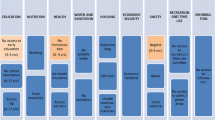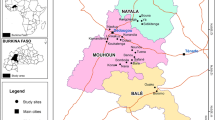Abstract
As a result of the increased acknowledgment that children deserve a special focus in poverty measurement, the range of measures aiming to capture the specific nature of child poverty and vulnerability has increased in size and scope over the last few years. Despite evidence that the timing of poverty matters and that children in different age brackets have different needs, child poverty approaches are largely developed for children as a homogenous group with limited age diversification. This paper aims to address this gap within the debate on child poverty and well-being measurement and presents an explorative study to assess and investigate the issues related to the measurement of poverty and vulnerability of a specific group in society, namely adolescent girls, on the basis of a standardized and widely available household survey. The Multiple Indicator Cluster Survey (MICS) 2006 data is used to investigate the specific situation of adolescent girls in Vietnam. The proposed conceptual framework is multi-disciplinary and multidimensional in nature and incorporates issues of well-becoming as well as well-being. Findings suggest that a diversified child poverty approach has the potential to capture and provide insight into issues specifically relevant for a particular group in society. Nevertheless, more debate is required to address the appropriate balance between the desire to draw a broadly interpretable picture on general conceptions of a specific group in society versus the acknowledgment of the complex and diverse realities that children in this group face. Future research should also be directed towards addressing the data limitations for diversified child poverty approaches.







Similar content being viewed by others
Notes
The results for all indicators can be found in the Appendix.
References
Alkire, S. (2008). Choosing dimensions: The capability approach and multidimensional poverty. In N. Kakwani & J. Silber (Eds.), The many dimensions of poverty. New York: Palgrave-Macmillan.
Amin, A. (2008). “ Enhancing the benefits of girls' livelihood initiatives” Transitions to adulthood brief no. 17. New York: The Population Council.
Amin, S., Diamond, I., Naved, R., & Newby, M. (1998). Transition to adulthood of female garment-factory workers in Bangladesh. Studies in Family Planning, 29(2), 185–200.
Banks, J., & Johnson, P. (1993). Children and household living standards. London: Institute for Fiscal Studies.
Barber, B., Eccles, J., & Stone, M. (2001). Whatever happened to the Jock, the Brain, and the Princess?: Young adult pathways linked to adolescent activity involvement and social identity. Journal of Adolescent Research, 16(5), 429–455.
Bearinger, L., Sieving, R., Ferguson, J., & Sharma, V. (2007). Global perspectives on the sexual and reproductive health of adolescents: patterns, prevention, and potential. Lancet, 369, 1220–1231.
Ben-Arieh, A. (2000). Beyond welfare: measuring and monitoring the state of children—new trends and domains. Social Indicators Research, 52(3), 235–257.
Bender, T. (1997). Assessment of subjective well-being during childhood and adolescence. In G. Phye (Ed.), Handbook of classroom assessment: Learning, achievement and adjustment. Elsevier.
Biggeri, M. (2007, February 2007). Choosing dimensions in the case of children’s wellbeing. Maitreyee, Human Development and Capability Association, Number 7.
Bradshaw, J., Hoelscher, P., & Richardson, D. (2006). An index of child well-being in the European Union. Social Indicators Research, 80(1), 133–177.
Brooks-Gunn, J., & Duncan, G. (1997). The effects of poverty on children. The Future of Children, 7(2), 55–71.
Chainfreau, J., & Burchardt, T. (2008). Equivalence scales: Rationales, uses and assumptions, Scottish Government, URL: http://www.scotland.gov.uk/Resource/Doc/933/0079961.pdf.
Chong, E., Hallman, K., & Brady, M. (2006). Investing when it counts. New York: Population Council/UNFPA.
Christensen, P., & James, A. (2008). Introduction: Researching children and childhood cultures of communication. In P. Christensen & A. James (Eds.), Research with children. Perspectives and practices. Routledge.
Duncan, G., & Brooks-Gunn, J. (1997). Consequences of growing up poor. New York: Russell Sage.
Duncan, G., & Brooks-Gunn, J. (2000). Family poverty, welfare reform, and child development. Child Development, 71(1), 188–196.
Duncan, G., Yeung, J. W., Brooks-Gunn, J., & Smith, J. R. (1998). How much does childhood poverty affect the life chances of children? American Sociological Review, 63(3), 406–423.
Erikson, E. (1968). Identity: Youth and crisis. New York: Norton.
Esping-Andersen, G., & Sarasa, S. (2002). The generational conflict reconsidered. Journal of European Social Policy, 12(1), 5–21.
Furby, L., & Beyth-Marom, R. (1992). Risk taking in adolescence: a decision-making perspective. Developmental Review, 12, 1–44.
Gordon, D., Nandy, S., Pantazis, C., Pemberton, S., & Townsend, P. (2003a). Child poverty in the developing world. Bristol: Policy Press.
Gordon, D., Nandy, S., Pantazis, C., Pemberton, S., & Townsend, P. (2003b). The distribution of child poverty in the developing world. Bristol: Centre for International Poverty Research.
Haveman, R., & Wolfe, B. (1995). The determinants of children’s attainments: a review of methods and findings. Journal of Economic Literature, 33(4), 1829–1878.
Herrera, L. (2006). What’s new about youth? Development and Change, 37(6), 1425–1434.
Huebner, S. (1991). Initial development of the students’ life satisfaction scale. School Psychology International, 12, 231–240.
Huebner, S. (1994). Preliminary development and validation of a multidimensional life satisfaction scale for children. Psychological Assessment, 6, 149–158.
Huebner, S. (2004). Research on assessment of life satisfaction of children and adolescents. Social Indicators Research, 66(1), 3–33.
Huebner, S., Drane, W., & Valois, R. (2000). Levels and demographic correlates of adolescent life satisfaction reports. School Psychology International, 21(3), 281–292.
Igra, V., & Irwin, C. (1996). Theories of adolescent risk-taking behavior. In R. DiClemente, W. B. Hansen & L. Ponton (Eds.), Handbook of adolescent health risk behavior (pp. 35–53). New York: Plenum Press.
Impett, E., & Tolman, D. (2006). Late adolescent girls’ sexual experiences and sexual satisfaction. Journal of Adolescent Research, 21(6), 628–646.
Katz, E. (2008). “Programs promoting young womens' employment: what works?”, The Adoloscent Girls Initiative. Washington DC: World Bank.
Kleinert, S. (2007). Adolescent health: an opportunity not to be missed. Lancet, 369(9567), 1057–1058.
Lesko, N. (1996). Denaturalizing adolescence. The politics of contemporary representations. Youth & Society, 28(2), 139–161.
Levinson, D. (1986). A conception of adult development. The American Psychologist, 41(1), 3–13.
Moore, K. A., Theokas, C., Lippman, L., Bloch, M., Vandivere, S., & O’Hare, W. (2008a). A microdata child well-being index: conceptualization, creation, and findings. Child Indicators Research, 1(1), 17–50.
Moore, K. A., Vandivere, S., Atienza, A., & Thiot, T. (2008b). Developing a monitoring system for indicators in middle childhood: identifying measures. Child Indicators Research, 1(2), 129–155.
Morrison, A., & Sabarwal, S. (2008). The economic participation of adolescent girls and young women: Why does it matter? PREM notes, Washington DC: World Bank.
Muellbauer, J. (1979). McClements on equivalence scales for children. Journal of Public Economics, 12(2), 221–231.
Noble, M., Wright, G., & Cluver, L. (2006). Developing a child-focused and multidimensional model of child poverty for South Africa. Journal of Children and Poverty, 12(1), 39–53.
Qvortrup, J. (1997). Indicators of childhood and intergenerational dimension. In A. Ben-Arieh & H. Wintersberger (Eds.), Monitoring and measuring the state of children—Beyond survival (pp. 101–112). Vienna: European Centre for Social Welfare Policy and Research.
Qvortrup, J. (1999). The meaning of child’s standard of living. In A. Bowers Andrews & N. Hevener Kaufman (Eds.), Implementing the UN Convention on the rights of the child: A standard of living adequate for development. Praeger Publishers.
Ravallion, M. (1992). Does undernutrition respond to incomes and prices? Dominance tests for Indonesia. The World Bank Economic Review, 6(1), 109–124.
Ravallion, M., & Bidani, B. (1994). How robust is a poverty profile? The World Bank Economic Review, 8(1), 75–102.
Ray, R. (1986). Demographic variables and equivalence scales in a flexible demand system: the case of AIDS. Applied Economics, 18, 265–278.
Roelen, K., & Gassmann, F. (2008). Measuring child poverty and well-being: A literature review. Maastricht: Maastricht Graduate School of Governance.
Roelen, K., Gassmann, F., & Neubourg, C. D. (2009a). Child poverty in Vietnam—providing insights using a country-specific and multidimensional model. Maastricht: Maastricht Graduate School of Governance.
Roelen, K., Gassmann, F., & Neubourg, C. D. (2009b). The importance of choice and definition for the measurement of child poverty- the case of Vietnam. Child Indicators Research, 2(3), 245–263.
Schultz, T. P. (2002). “Why governments should invest more to educate girls.” World Development, 30(2), 207–225.
Sells, W., & Blum, R. (1996). Current trends in adolescent health. In R. DiClemente, W. B. Hansen & L. Ponton (Eds.), Handbook of adolescent health risk behavior. Springer.
Streeten, P. (1984). Basic needs: some unsettled questions. World Development, 12(9), 973–978.
Tedford, J., Capps, O., & Havlicek, J. (1986). Adult equivalent scales once more: a developmental approach. American Journal of Agricultural Economics, 68(2), 322–333.
Trzcinski, E., & Holst, E. (2008). Subjective well-being among young people in transition to adulthood. Social Indicators Research, 97(1), 83–109.
Wagmiller, R., Lennon, M. C., Kuang, L., Alberti, P., & Aber, L. (2006). The dynamics of economic disadvantage and children’s life chances. American Sociological Review, 71(5), 847–866.
White, S. (2002). Being, becoming and relationship: conceptual challenges of a child rights approach in development. Journal of International Development, 14(8), 1095–1104.
White, H., & Masset, E. (2006). Using adult equivalence scales to estimate income-poverty for different age groups. Young Lives Working Paper, No. 6.
WHO (2010). Child and adolescent health. WHO.
Woodhead, M., & Faulkner, D. (2008). Subjects, objects or participants? Dilemmas of psychological research with children. In P. Christensen & A. James (Eds.), Research with children. Perspectives and practices. Routledge.
Author information
Authors and Affiliations
Corresponding author
Appendix
Appendix
Rights and permissions
About this article
Cite this article
Roelen, K. Girls in Transition—How to Build Evidence and Gain Insight. Child Ind Res 5, 55–75 (2012). https://doi.org/10.1007/s12187-011-9113-7
Accepted:
Published:
Issue Date:
DOI: https://doi.org/10.1007/s12187-011-9113-7




